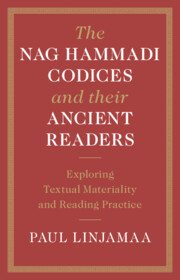The list of symbols I use in the translation and transcription of Coptic texts follows the sigla from The Coptic Gnostic Library editions, under the general editorship of James Robinson.Footnote 1 These are as follows:
| ⲁ̣ | A dot placed under a letter in the transcription (as in the example here to the left under the Coptic letter alpha, ⲁ) indicates that the letter is visually uncertain, even though the context may make the reading certain. A dot on the line outside of brackets in the transcription indicates an uncertain letter from which some vestiges of ink remain. |
| [ ] | Square brackets in the transcription indicate a lacuna in the MS where writing most probably at one time existed. When the text cannot be reconstructed but the number of missing letters can reasonably be estimated, that number is indicated by a corresponding number of dots; where the number of missing letters cannot be reasonably estimated, the space between the brackets is filled with three dashes. In the translation the square brackets are used only around words which have been substantially restored. |
| ⟦ ⟧ | Double square brackets indicate letters cancelled by the scribe. |
| { } | Braces indicate letters unnecessarily added by the scribe. |
| ` ´ | High strokes indicate that the letter so designated was secondarily written above the line by the scribe. |
| < > | Pointed brackets in the transcription indicate an editorial correction of a scribal omission. In the translation they indicate words which have been editorially emended. |
| ( ) | Parentheses in the transcription indicate scribal abbreviations which have been editorially explicated. In the translation they indicate material supplied by the translator for the sake of clarity. |

